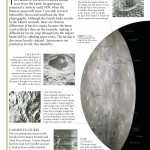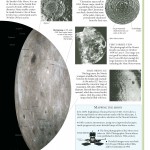The farside of the moon is always turned away from the Earth. Its appearance remained a mystery until 1959, when the Russian spacecraft Luna 3 was able to travel behind the Moon and send back the first photographs.
Although the farside looks similar to the moon’s nearside, there are obvious differences. It has few maria, because the lunar crust is thicker than on the nearside, making it difficult for lava to seep through into the impact basins left by colliding space rocks.
The north and south poles were the last parts of the Moon to be mapped. This was done by the Clementine spacecraft in 1994.
Mosaic maps, made by assembling the thousands of images that Clementine sent back, showed that some of the polar craters are permanently shadowed from the Sun’s rays.
Related posts:
The work of the Austrian physical Ludwig Boltzmann suggested an answer to the question: why does time seem to go only in one direction ? Boltzmann suggested that the amount of disorder, or entropy, in the universe increases over time.
The Lunar module Descent stage would be the final module for the vehicle. The Stage consists of the Engine Mount, The Descent engine, the Structural Skin, the Insulation, the thermal and micrometeoroid shield, the forward interstate fitting, the oxidizer tank, the cable cutter, the ambient helium tank, the landing gear and finally the descent engine skirt.
The rings of Saturn are the most far reaching planetary ring framework of any planet in the Earth's planetary group. They comprise of endless minor particles, running in size from micrometres to metres,that circle about Saturn. The ring particles are made just about truly of water ice, with a follow segment of rough material. There is still no agreement as to their mechanism of creation; certa...
Radio waves are the same type of waves as light. They have less energy than visible light and so have a longer wavelength, but they travel at the same speed as light. At night our eyes and optical telescopes sees light from stars. But normal stars only produce radio waves very weakly.
Mercury is the deepest planet in the Earth's planetary group. It's additionally the most diminutive, and its circle is the most unconventional (that is, the slightest splendidly roundabout) of the eight planets. It circles the Sun once in the vicinity of 88 Earth days, finishing several revolutions about its hub for each two circles. The planet is named following the Roman god Mercury, the det...
The movements in the Heavens are interminable and consummate, and the ideal movement is the round one, which, unlike the natural up-and down-ward headways, can final interminably similar. As substances, heavenly figures have matter (aether) and a shape: it appears that Aristotle did see them as living creatures with a reasonable soul as their shape.
Electrons unite with protons and neutrons to structure particles, ordinarily hydrogen and helium. Light can at final sparkle. Gravity makes hydrogen and helium gas mixes to shape the goliath fogs that can come to be universe sized frameworks; more unobtrusive packs of gas ruin to structure the first stars.
A supernova (shortened SN, plural SNe following supernovae) is a stellar outburst that is more enthusiastic than a nova. It's maintained /ˌsuːpərˈnoʊvə/ with the plural supernovae /ˌsuːpərˈnoʊviː/ or supernovas. Supernovae are greatly iridescent and create a blast of radiation that regularly briskly eclipses a whole universe, before blurring from perspective over some weeks or months. Aroun...
Red Planet happens to be host to 5 working spacecraft: a few within side orbit—the Mars Odyssey, Mars Convey, and also Red Planet Reconnaissance Orbiter; and a couple on the surface—Mars Pursuit Rover Chance and also the Red Planet Science Laboratory Curiosity. Defunct ballistic capsule at first glance contain MER-A Spirit, and several additional nonmoving landers as well as rovers, both profi...
The square of Pegasus is the key pattern to look for. Its four stars, although not particularly bright, are easy to find because there are few other stars around.
Uranus is the seventh planet from the Sun. It has the third-most vast planetary span and fourth-most impressive planetary mass in the Earth's planetary group. Uranus is comparative in arrangement to Neptune, and both are of offbeat substance structure than the more vast gas goliaths Jupiter and Saturn. Astrochemists in some cases place them in a marked classification called "ice goliaths". Ura...
Vostok 1 (Russian: Восток-1, East 1 or Arrange 1) was the first spaceflight in the Vostok system and the first human spaceflight in history. The Vostok 3KA space apparatus was started on April 12, 1961. The flight took Yuri Gagarin, a cosmonaut from the Soviet Union, into space. The flight checked the first time that a human dropped in space, and in addition the first orbital flight of a manne...
Consistent with Aristotle, the great figures are the absolute best substances, (or "substances"), whose movements are managed by standards different than these of figures in the sublunary circle.
A lunar stage or stage of the moon is the manifestation of the lit up (sunlit) divide of the Moon as viewed by a spectator, generally on Earth. The lunar stages update cyclically as the Moon circles the Earth, as per the adapting relative positions of the Earth, Moon, and Sun. The part of the lunar surface challenging the Sun is continuously sunlit, anyway the allotment of this lit up side ...
The Apollo Launch Escape System mainly consists of three modules namely Launch Escape Assembly, Command Module and Service Module. The command module refers to the Docking Mechanism, Drogue parachutes along with the Side hatch. This compartment also consists of Tanks, reaction, Control Engine, Wiring and the Plumbing mechanism. The Service module has the Helium tanks, Reaction Control System a...
How much damage can a space debris do ? An example of the damage caused, a tiny speck of paint from a satellite once dug, a pit in a space shuttle window nearly a quarter – inch wide. 1mm metal chip could do as much damage as a 0.22-caliber long rifle bullet. A pea-sized ball moving this fast is as dangerous as a 400 lb safe travelling at 60 mph. A metal sphere the size of a tennis ball is as l...
The “dark flow” of wayward galaxy clusters that appear to be pulled in one direction could give us our first hint of something beyond the cosmic horizon, which normally marks the limit of the observable universe.
Parallel to the Venus Express Mission, ESA has initiated an observing campaign that incorporates a number of professional and amateur observers. Since the cameras onboard Venus Express have only a small field of view, ground based observations can provide important context information on Venus’s dense atmosphere as a whole.



 Upload your infographic here and contribute to our community.
Upload your infographic here and contribute to our community. 
Leave a Reply